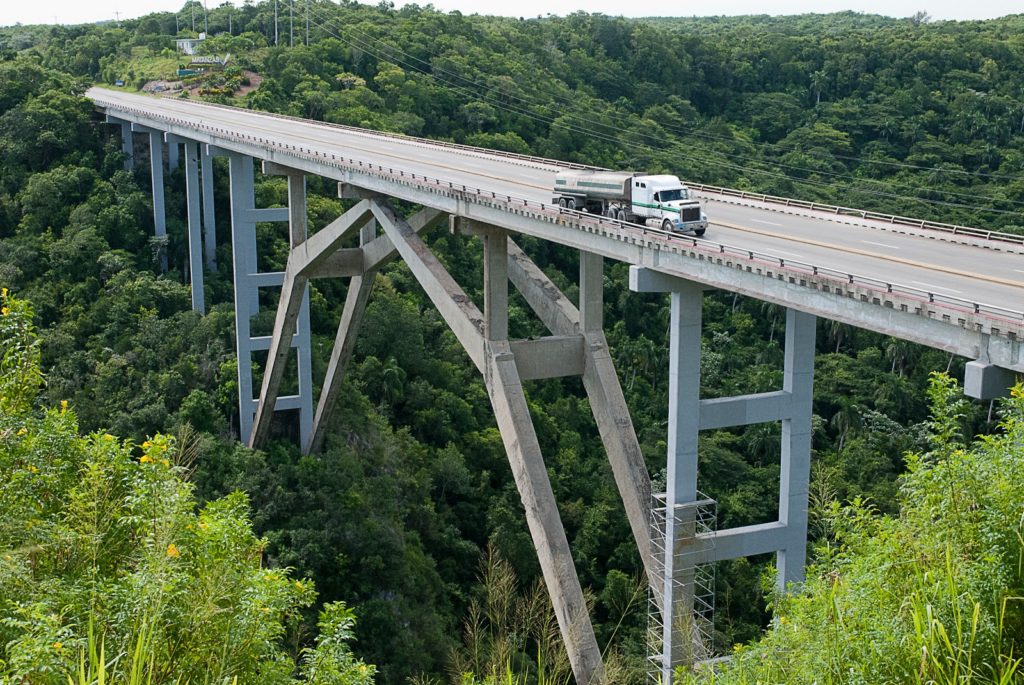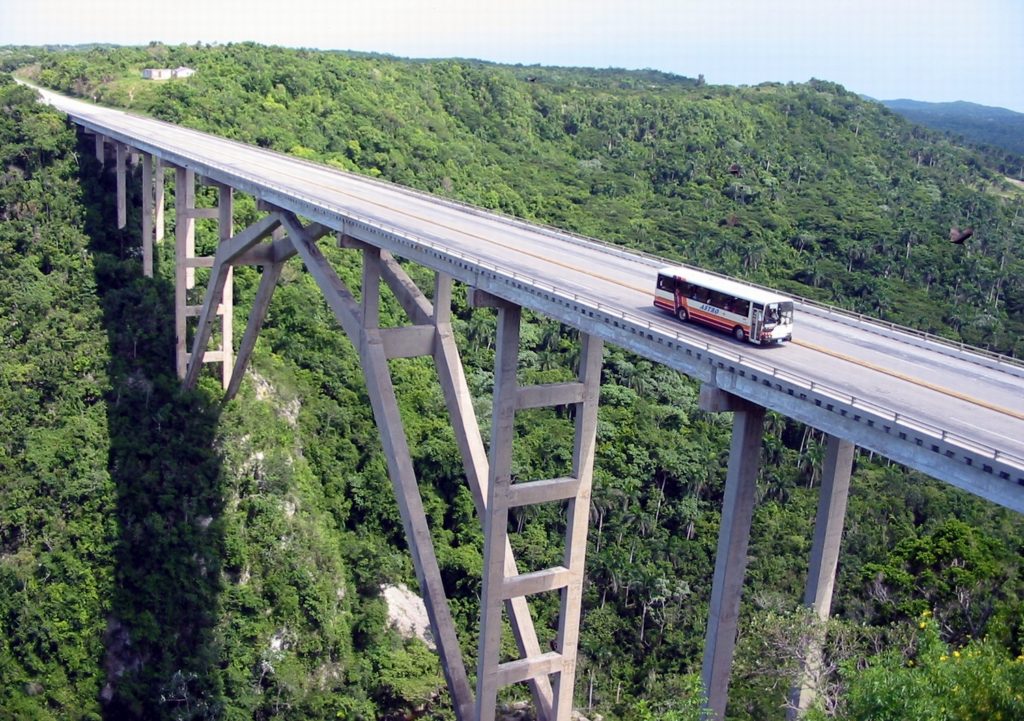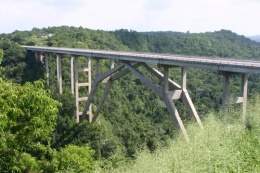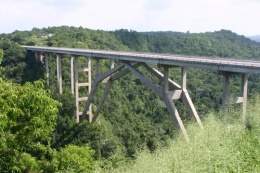 THE BRIDGE OF BACUNAYAGUA, MATANZAS. ONE OF THE WONDERS OF THE CUBAN ENGINEERING.
THE BRIDGE OF BACUNAYAGUA, MATANZAS. ONE OF THE WONDERS OF THE CUBAN ENGINEERING.
The Bacunayagua Bridge, in the Matanzas province, Cuba is considered historically one of the wonders of Cuban civil engineering.
Beginning the construction of this bridge in 1956 until its inauguration in September 1959, the Cuban island had the opportunity to inaugurate the longest and tallest bridge in Cuba. Built on the borders of the province of Havana and Matanzas, its construction is an intersection with the Vía Blanca (the road that connects Havana City and Varadero). It was intended to shorten the distance between Matanzas and Havana.
The project was carried out by the SACMAG firm (Sáenz, Cancio, Arvesu, Martín, and Gutiérrez) and the bridge was carried out by Cuban engineers led by Luis Sáenz Duplace and Manolo Arvesu. For the construction of the bridge, ingenious and daring alternatives were sought due to the conditions of the terrain on which it stands. One of these alternatives is the first use in Cuba of semi-arches, according to the technique of the Austrian engineer Josef Melan, who was the inventor of »the Melan system«, a method for the construction of reinforced bridges. The use of the so-called arch It is the newest feature of the bridge since it was built with laminated steel that was assembled in two parts, rotating each until achieving the correct position.
Its length is 313.50 meters with 11 lights of 28.50 meters. It is the highest bridge in Cuba with 103.50 meters from the river level to the pavement.
This pass is located 18 kilometers west of the city of Matanzas and establishes the territorial limit of this province with that of Mayabeque. To the north of the bearing track, you can see the sea; and the bed and the mouth of what is a remote time must have been the bed of a mighty river. To the south, you can see the Yumurí Valley.
The Bacunayagua Bridge is based directly on the rock with the support of Vierendel-type towers, post-tensioned in the central arch. The beams were placed using launch armor and weigh 47 tons each. The piles were cast with sliding molds, and everything was done in a lush area of difficult access. Its length is 313.50 meters with 11 lights of 28.50 meters and it is the highest bridge in Cuba with 103.50 meters from the river level to the pavement.
The bridge is made up of closed abutments and the piers are made up of porticos with two columns supported by the rock, except for the three central piers that are supported by two symmetrical polygonal arches joined at their knots by highly rigid crossbeams, and on the columns a head that supports the beams.
This bridge over the Vía Blanca, between Mayabeque and Matanzas, has the longest free span in Cuba at 114 meters. Its location on a deep gorge near the sea, makes it save a height of more than 100 meters, where there is a strong wind that complicated its construction. The project was carried out by the firm Sáenz, Cancio, Martín, and its main designer was the engineer Luis Sáenz Duplace.
The Bacunayagua Bridge was the last link missing to complete the Vía Blanca, which was built in the mid-20th century with the aim of uniting the cities of Havana and Matanzas. Its length is 313.50 meters with 11 lights of 28.50 meters and it is the highest bridge in Cuba with 103.50 meters from the river level to the pavement.
A peculiarity in its construction is that it did not have any falsework, it was completely prefabricated and the roof has reinforced concrete beams, which save 28 meters of light with a 1.30 depth and a thickness of 15 cm.
The beauty of the Bacunayagua environment, favored by the execution of this advanced project, alternates with a multitude of headlands, slopes, and mangroves, a natural refuge of great ornithological importance where 74 species of birds coexist with 16 reptiles and eight amphibians. In the swamp ecosystem of this area, plant formations appear as the coastal health xeroform and the semi-deciduous forest, in addition to a rich and varied fauna with a high percentage of endemism.
The magnitude and the splendid image of the place can be perfectly appreciated from the Mirador, located in an elevation to the west end of the wonderful work.
 EL PUENTE DE BACUNAYAGUA, MATANZAS. UNA DE LAS MARAVILLAS DE LA INGENIERIA CUBANA.
EL PUENTE DE BACUNAYAGUA, MATANZAS. UNA DE LAS MARAVILLAS DE LA INGENIERIA CUBANA.
El Puente de Bacunayagua, en la provincia de Matanzas, Cuba es considerado como una las siete maravillas de la ingeniería civil cubana.
Comenzada la constructión de este puente en 1956 hasta su inauguracion en Septiembre de 1959, la isla cubana tuvo la oportunidad de inaugurar el puente más largo y más alto en Cuba . Construido en las fronteras de la provincia de La Habana y Matanzas su construcción es históricamente un entrecruzado con la Vía Blanca (la carretera que une Ciudad de La Habana y Varadero ) fue su fin el acortar la distancia entre Matanzas y La Habana .
El proyecto lo realizó la firma SACMAG (Sáenz, Cancio, Arvesu, Martín y Gutiérrez) y la ejecución del puente estuvo a cargo de ingenieros cubanos dirigidos por Luis Sáenz Duplace y Manolo Arvesu. Para la construcción del puente se buscaron ingeniosas y atrevidas alternativas debido a las condiciones del terreno sobre el que se erige. Una de estas alternativas la constituye el uso por primera vez en Cuba de semiarcos, según la técnica del ingeniero austríaco Josef Melan, que fue inventor de »sistema de Melan«, método para la construcción de puentes reforzados. El uso del denominado arco es lo más novedoso del puente, ya que se construyó con acero laminado que se armó en dos partes, girando cada una hasta lograr la posición correcta.
Su largo es de 313.50 metros con 11 luces de 28.50 metros. Es el puente más alto de Cuba con 103.50 metros del nivel del río al pavimento.
Este paso se encuentra ubicado a 18 kilómetros al oeste de la ciudad de Matanzas y establece el límite territorial de esta provincia con la de Mayabeque. Al norte de la pista de rodamiento se divisa el mar; y el lecho y la desembocadura de lo que en una época remota debió ser el cauce de un caudaloso río. Al sur se puede observar el Valle de Yumurí.
El Puente de Bacunayagua está cimentado directamente en la roca con apoyo de torres tipo Vierendel, postensadas en el arco central. Las vigas se colocaron mediante armadura de lanzamiento y tienen 47 toneladas de peso cada una. Las pilas fueron fundidas con moldes deslizantes, y todo realizado en una exuberante zona de difícil acceso. Su largo es de 313.50 metros con 11 luces de 28.50 metros y es el puente más alto de Cuba con 103.50 metros del nivel del río al pavimento.
Está formado el puente por estribos cerrados y las pilas están formadas por pórticos de dos columnas apoyadas en la roca, excepto las tres pilas centrales que se apoyan sobre dos arcos poligonales simétricos unidos en sus nudos por vigas transversales de gran rigidez, y sobre las columnas un cabezal que soporta las vigas.
Este puente sobre la Vía Blanca, entre Mayabeque y Matanzas, posee la luz libre más larga de Cuba con 114 metros. Su ubicación sobre una profunda garganta cerca del mar, le hace salvar una altura de más de 100 metros, donde existe un fuerte viento que complicó su construcción. El proyecto lo realizó la firma Sáenz, Cancio, Martín, siendo su proyectista principal el ingeniero Luis Sáenz Duplace.
El Puente de Bacunayagua era el último eslabón que faltaba para terminar la Vía Blanca, que se construyó a mediados del siglo XX con el objetivo de unir a las ciudades de La Habana y Matanzas. Su largo es de 313.50 metros con 11 luces de 28.50 metros y es el puente más alto de Cuba con 103.50 metros del nivel del río al pavimento.
Una peculiaridad en su construcción es que no tuvo ninguna falsa obra, fue prefabricado en su totalidad y la cubierta tiene vigas de hormigón reforzado, que salvan 28 metros de luz con un peralto de 1.30 y un espesor de 15 cm.
La belleza del entorno de Bacunayagua , favorecida por la ejecución de ese proyecto avanzado , se alterna con multitud de cabos , laderas y manglares, refugio natural de gran importancia ornitológica donde 74 especies de aves conviven con 16 de reptiles y ocho de anfibios. En el ecosistema del pantano de esta área formaciones vegetales aparecen como el xeroformo costera salud y el bosque semideciduo , además de una rica y variada fauna con alto porcentaje de endemismo.
La magnitud y la espléndida imagen del lugar se pueden apreciar perfectamente desde el Mirador , ubicado en una elevación al oeste final de la obra maravillosa.
Agencies/ Wiki/ Ecured/ Internet Photos/ YouTube/ Arnoldo Varona/ www.TheCubanHistory.com
THE CUBAN HISTORY, HOLLYWOOD.



 -THE BRIDGE of Bacunayagua, Matanzas. One of the Wonders of the Cuban Engineering. PHOTOS.
-THE BRIDGE of Bacunayagua, Matanzas. One of the Wonders of the Cuban Engineering. PHOTOS.







